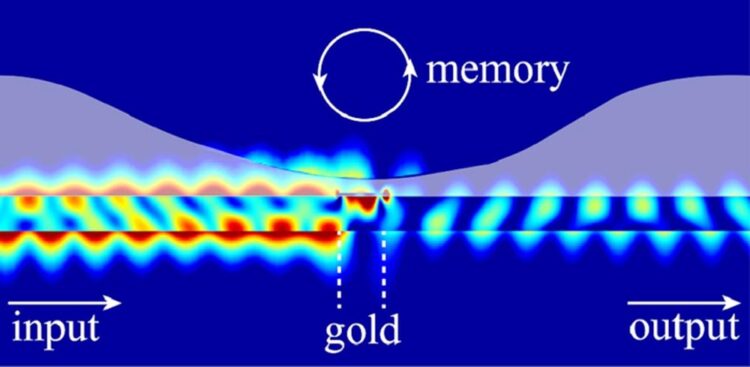Neuromorphic computing with optically driven nonlinear fluid dynamics

Simulation result of light affecting liquid geometry, which in turn affects reflection and transmission properties of the optical mode, thus constituting a two-way light–liquid interaction mechanism. The degree of deformation serves as an optical memory allowing to store the power magnitude of the previous optical pulse and use fluid dynamics to affect the subsequent optical pulse at the same actuation region, thus constituting an architecture where memory is part of the computation process.
Credit: Gao et al., doi 10.1117/1.AP.4.4.046005
Liquid film can function as optical memory, enabling new architectural horizons for nanoscale neuromorphic computing.
Sunlight sparkling on water evokes the rich phenomena of liquid–light interaction, spanning spatial and temporal scales. While the dynamics of liquids have fascinated researchers for decades, the rise of neuromorphic computing has sparked significant efforts to develop new, unconventional computational schemes based on recurrent neural networks, crucial to supporting wide range of modern technological applications, such as pattern recognition and autonomous driving. As biological neurons also rely on a liquid environment, a convergence may be attained by bringing nanoscale nonlinear fluid dynamics to neuromorphic computing.
Researchers from University of California San Diego recently proposed a novel paradigm where liquids, which usually do not strongly interact with light on a micro- or nanoscale, support significant nonlinear response to optical fields. As reported in Advanced Photonics, the researchers predict a substantial light–liquid interaction effect through a proposed nanoscale gold patch operating as an optical heater and generating thickness changes in a liquid film covering the waveguide.
The liquid film functions as an optical memory. Here’s how it works: Light in the waveguide affects the geometry of the liquid surface, while changes in the shape of the liquid surface affect the properties of the optical mode in the waveguide, thus constituting a mutual coupling between the optical mode and the liquid film. Importantly, as the liquid geometry changes, the properties of the optical mode undergo a nonlinear response; after the optical pulse stops, the magnitude of liquid film’s deformation indicates the power of the previous optical pulse.
Remarkably, unlike traditional computational approaches, the nonlinear response and the memory reside at the same spatial region, thus suggesting realization of a compact (beyond von-Neumann) architecture where memory and computational unit occupy the same space. The researchers demonstrate that the combination of memory and nonlinearity allow the possibility of “reservoir computing” capable of performing digital and analog tasks, such as nonlinear logic gates and handwritten image recognition.
Their model also exploits another significant liquid feature: nonlocality. This enables them to predict computation enhancement that is simply not possible in solid state material platforms with limited nonlocal spatial scale. Despite nonlocality, the model does not quite achieve the levels of modern solid-state optics-based reservoir computing systems, yet the work nonetheless presents a clear roadmap for future experimental works aiming to validate the predicted effects and explore intricate coupling mechanisms of various physical processes in a liquid environment for computation.
Using multiphysics simulations to investigate coupling between light, fluid dynamics, heat transport, and surface tension effects, the researchers predict a family of novel nonlinear and nonlocal optical effects. They go a step further by indicating how these can be used to realize versatile, nonconventional computational platforms. Taking advantage of a mature silicon photonics platform, they suggest improvements to state-of-the-art liquid-assisted computation platforms by around five orders magnitude in space and at least two orders of magnitude in speed.
Read the Gold Open Access article by Chengkuan Gao, Prabhav Gaur, Shimon Rubin, and Yeshaiahu Fainman, “Thin liquid film as an optical nonlinear-nonlocal medium and memory element in integrated optofluidic reservoir computer,” Adv. Photon. 4(4) 046005 (2022), doi 10.1117/1.AP.4.4.046005.
Journal: Advanced Photonics
DOI: 10.1117/1.AP.4.4.046005
Article Title: https://www.spiedigitallibrary.org/journals/advanced-photonics/volume-4/issue-04/046005/Thin-liquid-film-as-an-optical-nonlinear-nonlocal-medium-and/10.1117/1.AP.4.4.046005.full
Article Publication Date: 25-Jul-2022
Media Contact
Daneet Steffens
SPIE–International Society for Optics and Photonics
daneets@spie.org
Office: 360-685-5478
All latest news from the category: Information Technology
Here you can find a summary of innovations in the fields of information and data processing and up-to-date developments on IT equipment and hardware.
This area covers topics such as IT services, IT architectures, IT management and telecommunications.
Newest articles

Innovative 3D printed scaffolds offer new hope for bone healing
Researchers at the Institute for Bioengineering of Catalonia have developed novel 3D printed PLA-CaP scaffolds that promote blood vessel formation, ensuring better healing and regeneration of bone tissue. Bone is…

The surprising role of gut infection in Alzheimer’s disease
ASU- and Banner Alzheimer’s Institute-led study implicates link between a common virus and the disease, which travels from the gut to the brain and may be a target for antiviral…

Molecular gardening: New enzymes discovered for protein modification pruning
How deubiquitinases USP53 and USP54 cleave long polyubiquitin chains and how the former is linked to liver disease in children. Deubiquitinases (DUBs) are enzymes used by cells to trim protein…



